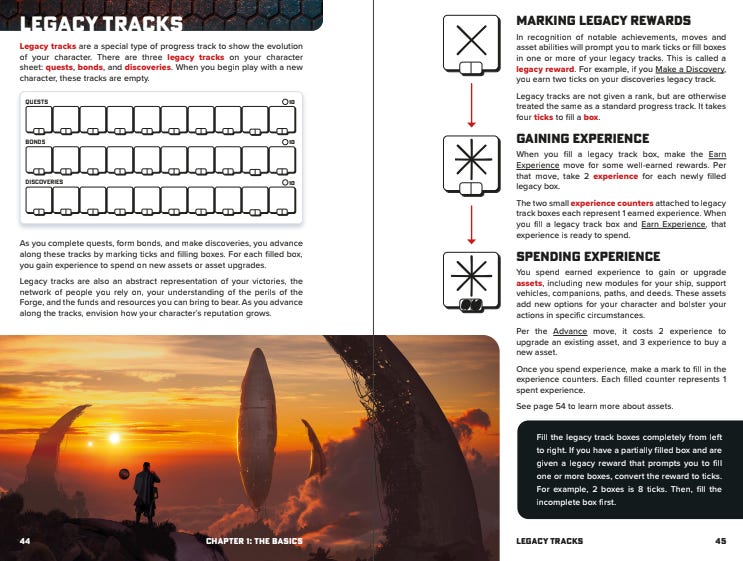Your RPG rulebook should begin with a 32-page quick-start in the front
The Ironsworn rulebooks are the most well-structured, clear, and useful RPG core books I've ever read, and should be the standard for how to teach a system to a GM
The title of the post is the big takeaway after another runaway Reddit post I wrote. First I’ll give you the whole shtick all over again, and then I’ll put at the bottom all of my new biggest takeaways.
The thesis: The Ironsworn books are wonderfully readable rulebooks for all kinds of learners and players.
After GMing for a dozen systems for over 20 years, I have to admit something terrible: I’ve never read a core rulebook cover-to-cover. Of course I’ve read the entire rulebook for most of the games I’ve run, in some order or another. But not linearly, starting on the first page, going chapter by chapter, absorbing the information therein, and then ending on the final page.
Most RPG books simply don’t lend themselves to being read that way, even if you try. You read the table of contents and see that the GM guidelines are at the end, and so you skip to those. Or the second chapter starts you off making a character and just asks you to patiently generate stats and ability you don’t understand, so you skip around constantly trying to make sense of it as you go. Writing an RPG core book is tough to get right!
And then I read the Ironsworn rulebooks. For those of you who don’t know, Ironsworn is a fiction-first fantasy game, available for free, that’s engineered for solo play, co-op, or a GM’d version, refined further and more perfectly in its sci-fi sequel Ironsworn: Starforged. These books are 255 and 400 pages respectively, and I read them easily cover to cover.
These books are a triumph. Regardless of whether or not you are interested in the system, they are well-designed books in terms of teaching the game. And they have a bigger task on their shoulder, because they are teaching a genre of gaming I’m betting most of its readers aren’t used to.
There are plenty of things that these books do that others do as well, but here are some unique things I think the Ironsworn books have that I just don’t see as clearly in other books:
The books start with a quick, visual, complete rules primer like you’d find in a starter set, and then presents all of the information a second time later in more elaborate deep dives, so that you can get the full comprehension of the system up front before delving into constituent parts. (as opposed to books that tell you everything about character creation before telling you anything about resolving attack rolls) .
The book is constantly showing you how its own information is organized. The table of contents practically lists every page, sometimes twice, and there are robust indexes. Whenever a rule from another chapter is mentioned, it tells you what page, even when that information is ahead in the book, so you know if you’ve missed something or not. Starforged further includes an outline of the book’s structure at the beginning. All of this is clickable in the PDF.
It’s chock full of visual diagrams, examples, icons, flowcharts. You’re never simply told about something when you can be shown instead. Plenty of rulebooks are pretty, and have nice layouts and art to give you a sense of the setting, sure, but the Ironsworn books put a lot of this design effort into visual aids that actually teach you the game.
The book tells you things like “this chapter is for referencing, not for reading straight through,” which guides your focus and tells you what sorts of things are important to remember.
For both rulebooks, there is an available reference guide that is the actual document you need for the table (rules reverence, moves list, random generation tables), beautifully presented, so that your rulebook can remain on the shelf during play unless you need a deep dive reference.
The Fantasy book is free, but the Sci-Fi book is stunning, and also worth it.
Bravo to Shawn Thomkin, I hope you keep writing for your players and fans, and that they do everything they can to make you rich
Other notes and insights
Since I wrote the above screed like two months ago, here are some things I’ve worked out, usually through debate in the comments:
The part of that post that most resonated was the part where the first ~30 pages should be the entire rules primer, written to quick-start your game, before the rest of the book deep-dives into the various chapters on each part of the system. NOTE: The Call of Cthulhu community’s default answer to “what do I need to run the game?” is not The Keeper’s Handbook but The Starter Kit.
A book should overexplain for clarity instead of under explain hoping they were brief. This goes against all sorts of writing advice, but this is a teaching text we’re talking about. It should go “Here’s how it works. Don’t get it? Here’s a chart. Don’t get it yet? Here’s an example of play. Don’t get it yet? Here’s…”
Where I’m headed….
I have something half-written about how to proactively grow and expand your TTRPG community, and so teaching new games is an interesting topic to me. I hope it’s interesting to you. Let me know if it is.





Couldn't agree more. LOVE Tomkin's work. I backed Starforged at it's highest level and haven't regretted it a bit. Fantastic system. Fantastic game. Fantastic author with a FANTASTIC attitude. Some of his writings about writing his game are just HUMBLING. Look forward to meeting him some day. This was my very first foray into solo play. Loved it!